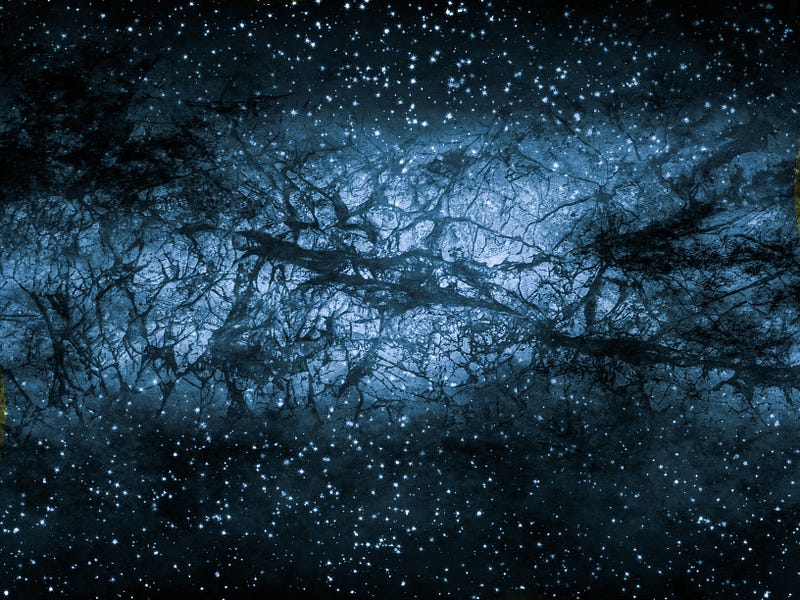Developing the theory of dark matter
By Emily Dyer, Physics, 2022

Human beings have a very limited view of space. The measurements we can take are often clouded by background radiation and interference from the infinite universe. This often causes astronomers to propose the existence of things we cannot see to explain what we can. Sometimes this works wonderfully. Before Neptune was observed, an astronomer proposed its existence simply by watching the orbit of one of Uranus’s moons. Other times it is less successful, such as the idea of an ether, or how Ancient Greeks concluded that the Earth was inside two dark, rotating spheres holding the sun and the stars. Similarly, the idea of dark matter was proposed when scientists observed that the structure of the galaxy was not possible according to Newtonian physics.
In 1932, an astronomist named Jan Oort was observing the motion of stars and realized that they didn’t make sense according to the visible mass of the galaxy. Oort estimated that the visible mass we see makes up only 50 percent of our galaxy. Nowadays, we know this was a very rough estimate. Current research shows that visible matter makes up about five percent of the universe. Things only got more suspicious during the late 60s and 70s.
As computing power grew, scientists started creating simulations using Newtonian physics to recreate the Milky Way. The result was completely different from the galaxy we live in. The Milky Way is in a state of equilibrium, meaning that the centrifugal force should cancel out the force of gravity towards the center, making the stars travel along circular paths. What the simulation showed was a chaotic galaxy with large, elliptical orbits and no spiral structure. This model wasn’t supported by centrifugal force, but rather by pressure, putting the computed Milky Way at an incredibly high temperature.
In 1932, an astronomist named Jan Oort was observing the motion of stars and realized that they didn’t make sense according to the visible mass of the galaxy
In order to fix this simulation, Jerry Ostriker theorized that there was a spheroidal “halo” of mass surrounding galaxies. This halo would increase gravitational potential energy without increasing kinetic energy, thereby stabilizing the system. There were no visible signs of the spheroidal mass, so it was dubbed the dark halo. Ostriker and his partner, James Peebles, suggested the extra mass was caused by objects with a low luminosity. The dark halo was later named “dark matter.”
Of course, this was not the only explanation provided. One of dark matter’s competing theories is modified Newtonian dynamics (MOND) proposed by Mordehai Milgrom. Milgrom argued that Newtonian dynamics only applied to relatively small accelerations achievable on Earth. The law of inertia is normally expressed as F = ma, but in MOND it would become:

With a0 being a fundamental acceleration. MOND has held up with observations made of the universe, but for some time there was debate around its inability to explain gravitational lensing.
Gravitational lensing is the one of the other impacts of dark matter. As light passes by clusters of matter, the attractive force of gravity bends the path of light to create a ring around the mass. Based on the light’s angle of deflection, it was concluded that the mass of the clusters must be much greater than the visible mass. This questioned the validity of MOND until theories such as TeVeS applied general relativity to the modified system.
The main reason why dark matter is more commonly accepted than MOND is that it is just simpler. MOND requires us to adjust Newton’s laws, which are a fundamental part of our understanding of physics. Dark matter provides a solution without having to make these changes. Scientists often try to follow simpler explanations for why the universe is the way it is, just like how the ancient Greek idea of spheres rotating around Earth was abandoned when the simpler Copernican explanation was presented.
What the simulation showed was a chaotic galaxy with large, elliptical orbits and no spiral structure.
Despite its acceptance in the scientific community, it is difficult to say what dark matter actually is. The main way in which dark matter is “seen” is by its gravitational effects. Beyond that, it has very little to no interactions with visible matter. Even if researchers were to obtain a sample of dark matter it would easily escape whatever device it was held in. This means it is much easier to find out what dark matter isn’t. The main theory being explored is that dark matter is made up of Weakly Interacting Massive Particles (WIMPs). Since these particles cannot be directly seen, researchers in labs like CERN are looking for their slight interactions with other particles by measuring small changes in energy and momentum of systems.
Sanders, R. H. “The Dark Matter Problem.” (2010) DOI:10.1017/cbo9781139192309
Astronomical Society of Australia (2001). DOI:10.1071/AS01017
